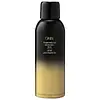What's inside
What's inside
 Key Ingredients
Key Ingredients

 Benefits
Benefits

 Concerns
Concerns

 Ingredients Side-by-side
Ingredients Side-by-side

Butane
Disiloxane
Skin ConditioningWater
Skin ConditioningPropane
Pvp
Emulsion StabilisingHippophae Rhamnoides Fruit/Seed Oil
AntimicrobialVp/Dmapa Acrylates Copolymer
Hydrolyzed Vegetable Protein
Skin ConditioningHydrolyzed Wheat Protein
Skin ConditioningCetyl PEG/PPG-10/1 Dimethicone
EmulsifyingPhenyl Trimethicone
Skin ConditioningPropylene Glycol
HumectantQuaternium-26
Polyquaternium-59
UV AbsorberButylene Glycol
HumectantEthylhexylglycerin
Skin ConditioningHexylene Glycol
EmulsifyingHydroxyethyl Behenamidopropyl Dimonium Chloride
Microcrystalline Wax
Emulsion StabilisingParaffin
PerfumingPolyethylene
AbrasiveBenzalkonium Chloride
AntimicrobialPhenoxyethanol
PreservativePotassium Sorbate
PreservativeSodium Benzoate
MaskingParfum
MaskingBenzyl Benzoate
AntimicrobialHydroxycitronellal
PerfumingLimonene
PerfumingCitronellol
PerfumingButane, Disiloxane, Water, Propane, Pvp, Hippophae Rhamnoides Fruit/Seed Oil, Vp/Dmapa Acrylates Copolymer, Hydrolyzed Vegetable Protein, Hydrolyzed Wheat Protein, Cetyl PEG/PPG-10/1 Dimethicone, Phenyl Trimethicone, Propylene Glycol, Quaternium-26, Polyquaternium-59, Butylene Glycol, Ethylhexylglycerin, Hexylene Glycol, Hydroxyethyl Behenamidopropyl Dimonium Chloride, Microcrystalline Wax, Paraffin, Polyethylene, Benzalkonium Chloride, Phenoxyethanol, Potassium Sorbate, Sodium Benzoate, Parfum, Benzyl Benzoate, Hydroxycitronellal, Limonene, Citronellol
Hydrofluorocarbon 152a
Sd Alcohol 40-B
AstringentButane
Acrylates/Octylacrylamide Copolymer
Isobutane
Isostearyl Alcohol
EmollientParfum
MaskingNeopentyl Glycol Diheptanoate
EmollientIsododecane
EmollientBenzophenone-4
UV AbsorberPanthenol
Skin ConditioningTocopheryl Acetate
AntioxidantRetinyl Palmitate
Skin ConditioningTocopherol
AntioxidantLimonene
PerfumingHexyl Cinnamal
PerfumingLinalool
PerfumingCitral
Perfuming
 Reviews
Reviews

Alternatives
Ingredients Explained
These ingredients are found in both products.
Ingredients higher up in an ingredient list are typically present in a larger amount.
Butane is a gas derived from petroleum and natural gas. It is used as an aerosol propellant.
Limonene is a fragrance that adds scent and taste to a formulation.
It's found in the peel oil of citrus fruits and other plants such as lavender and eucalyptus. The scent of limonene is generally described as "sweet citrus".
Limonene acts as an antioxidant, meaning it helps neutralize free radicals.
When exposed to air, oxidized limonene may sensitize the skin. Because of this, limonene is often avoided by people with sensitive skin.
The term 'fragrance' is not regulated in many countries. In many cases, it is up to the brand to define this term. For instance, many brands choose to label themselves as "fragrance-free" because they are not using synthetic fragrances. However, their products may still contain ingredients such as essential oils that are considered a fragrance.
Learn more about LimoneneParfum is a catch-all term for an ingredient or more that is used to give a scent to products.
Also called "fragrance", this ingredient can be a blend of hundreds of chemicals or plant oils. This means every product with "fragrance" or "parfum" in the ingredients list is a different mixture.
For instance, Habanolide is a proprietary trade name for a specific aroma chemical. When used as a fragrance ingredient in cosmetics, most aroma chemicals fall under the broad labeling category of “FRAGRANCE” or “PARFUM” according to EU and US regulations.
The term 'parfum' or 'fragrance' is not regulated in many countries. In many cases, it is up to the brand to define this term.
For instance, many brands choose to label themselves as "fragrance-free" because they are not using synthetic fragrances. However, their products may still contain ingredients such as essential oils that are considered a fragrance by INCI standards.
One example is Calendula flower extract. Calendula is an essential oil that still imparts a scent or 'fragrance'.
Depending on the blend, the ingredients in the mixture can cause allergies and sensitivities on the skin. Some ingredients that are known EU allergens include linalool and citronellol.
Parfum can also be used to mask or cover an unpleasant scent.
The bottom line is: not all fragrances/parfum/ingredients are created equally. If you are worried about fragrances, we recommend taking a closer look at an ingredient. And of course, we always recommend speaking with a professional.
Learn more about Parfum